Groundcover plants have a versatility that is unmatched by any other plant in the garden. From garden beds and rockeries to dull landscapes that need a lift, groundcover plants can fill the gaps and spaces to create a seamless effect of color and beauty.
Groundcover plants with white flowers are guaranteed to brighten up any garden. And when these low-growing white wonders combine with taller perennials and shrubs, the options are endless.
From spring through summer, your garden can be transformed with a freshness and elegance that only white flowers can bring.
If you want to brighten your garden with white, keep reading to find the right groundcover plant for you.
Table of Contents
1. Candytuft
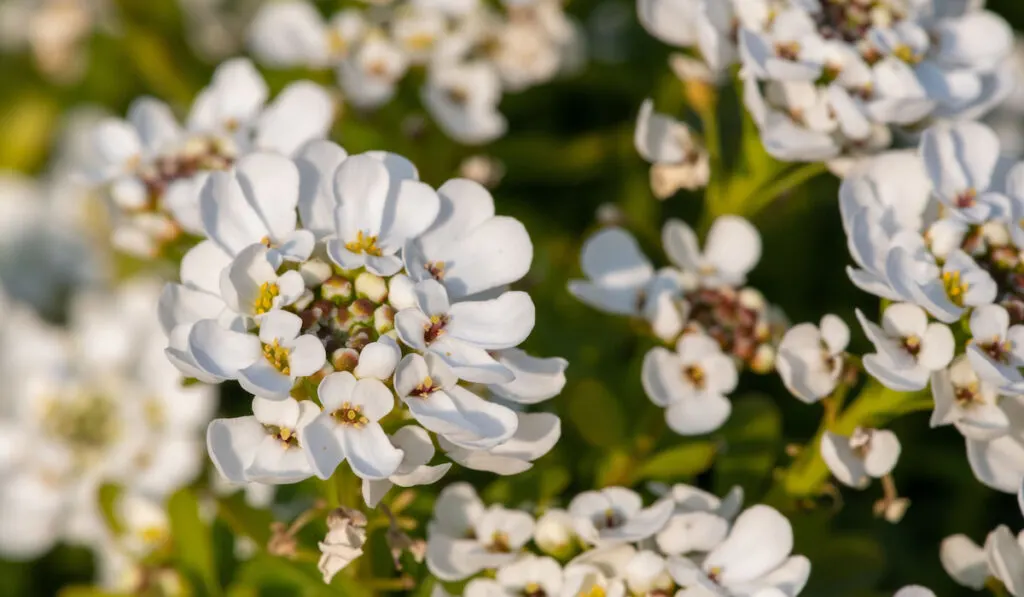
Candytuft is an extremely popular spring flowering plant. It works independently and in combination with other plants, like in a rock garden, for example. When in bloom, its glossy leaves form wavy clusters covered with swarms of tiny white blossoms.
Candytuft puts on a display of its tiny white flowers in April and May, but if you trim them by about one-third after they have faded, they may rebloom in the fall.
It thrives in full sun, and while it will also grow in light shade, its blooms won’t be as strong as when grown in full sun.
Candytuft loves moist but not drenched, sandy, loamy soil, but it also does well during short dry spells. Soils between neutral and slightly alkaline are optimal.
Key information:
- Hardiness zones: 3-9
- Heat zones: 3-9
- Mature size: 6″-1′ height; 1-2′ wide
- Prefers full-sun locations
- It is easy to grow and resistant to drought
- It blooms profusely
2. Rose ‘White Fairy’

‘White Fairy’ is one of the most beautiful roses in the groundcover rose family.
It spreads rapidly, forming extensive carpets of white blossoms. From spring until late October, this plant will flower abundantly.
While the blooms stay on the stems for only two to three weeks, the bush constantly generates new buds to create a long-lasting, brilliant white arrangement in your garden.
‘White Fairy’ is a low-maintenance plant that needs only minimal care. It does best in sunny locations with fertile, well-drained soil.
Key information:
- Hardiness zones: 4-9
- Heat zones: 5-9
- Mature size: 2-4’ height; 2-4’ wide
- Prefers full sun and partial shade
- Abundant flowering
- High frost tolerance
- Grows quickly
- Low cultivation requirements
- Recipient of the Award of Garden Merit (AGM)
3. Cerastium tomentosum ‘Snow-in-Summer’
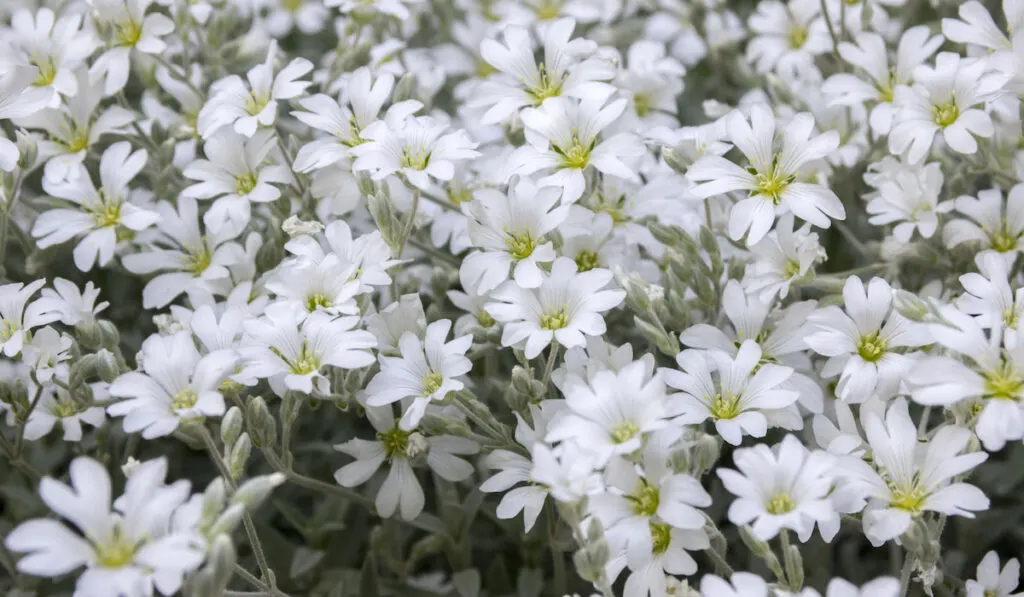
‘Snow-in-Summer’ is a low perennial from southern Italy that does well in sunny, dry positions and in barren soils.
The trouble-free growth, low nutrient requirements, flowering reliability, and capacity for ‘Snow-in-Summer’ to spread over an area quickly, set it apart from the rest.
It’s pure white flowers blossom from May through June and have a sweet honey scent.
The plant creates a very impressive pillow-like look, and the silvery-gray leaves make it beautiful even when not in bloom.
‘Snow-in-Summer’ grows naturally on dry and stony soil, so similar ground is preferable in the garden. It will grow nicely between paving slabs and form effective borders around individual pieces.
Key information:
- Hardiness zones: 5-9
- Heat zones: 1-7
- Mature size: 6”-1’ height; 6”-2’ wide
- Prefers full-sun locations
- Heavy blooming
- White small flowers
- Grows quickly
- Soil tolerant
- Drought and heat tolerant
- Low cultivation requirements
4. Creeping Phlox
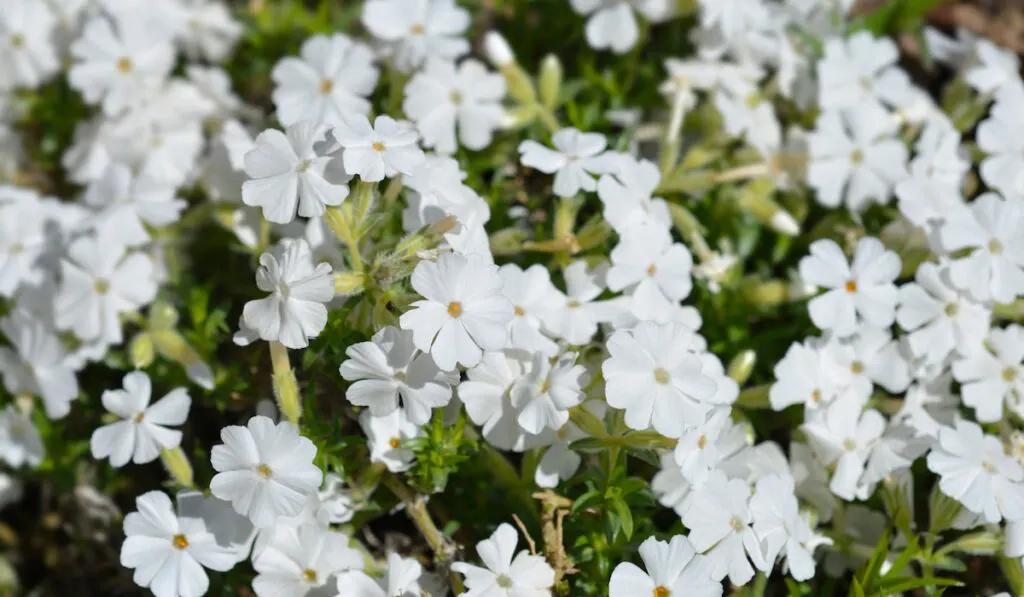
White creeping phlox is a fast-growing variety with snow-white blooms. With its fast-growing branches that root in the ground, it can form large carpets that cover a lot of ground.
Creeping phlox is an incredible perennial that produces many flowers while requiring modest maintenance.
A sunny position, average garden soil, and room to expand are all it needs to thrive. It can also withstand cold temperatures and doesn’t need any additional treatment.
Creeping phlox is a must-have in flower walls, beds, and rock gardens. Depending on the type, they can be any color from white to very pale lilac, pink to carmine, or purple to lavender.
It looks most beautiful among stones or when creating avalanches of hanging flowers on rock walls.
Recommended white Creeping phlox varieties include:
- ‘White Delight’ – an immensely popular variety with snow-white flowers.
- ‘Alba’ – a variety of Creeping phlox with white flowers with clearly separated petals.
- ‘Bavaria’ – the variety with cream-white flowers and a blue-purple eye.
- ‘Calvides White’ – variety with charming white flowers with a slight yellow dot in the middle.
- ‘Amazing Grace’ – a variety of white flowers with an intense dark pink center.
- ‘Spring White’ – the variety with white petals and yellow eyes.
Key information:
- Hardiness zones: 2-9
- Heat zones: 1-8
- Mature size: 4-6” height; 1-2’ wide
- Prefers full-sun locations
- It is easy to grow and resistant to drought
- Flowers come in many colors
- It blooms profusely
5. White Creeping Thyme

Creeping Thyme is a perennial groundcover plant. Beautiful in aroma and relatively unaffected by foot traffic, thyme is a must-have plant.
Creeping Thyme blooms from June to August, creating inflorescences with white flowers. It is a plant whose medicinal benefits are well known.
Thyme is a helpful herb for smokers and people with chronic bronchitis because it is good at cleaning and disinfecting the respiratory tract.
In addition to its usage as an herb, Creeping Thyme is ideal for rockeries, steep slopes, stone paths, and borders.
It couldn’t be easier to grow Creeping Thyme. Just remember that it needs a sunny location and soil that is not too wet.
Key information:
- Hardiness zones: 5-9
- Heat zones: 1-9
- Mature size: 2-3” height; 10”-1’ wide
- Prefers full-sun locations
- Abundant flowering
- Grows quickly
- Soil tolerant
- Low cultivation requirements
- Flowers attract butterflies and bees
- Herbs with medicinal properties
- Often used in cooking as a spice
6. Aubrieta ‘Regado White’
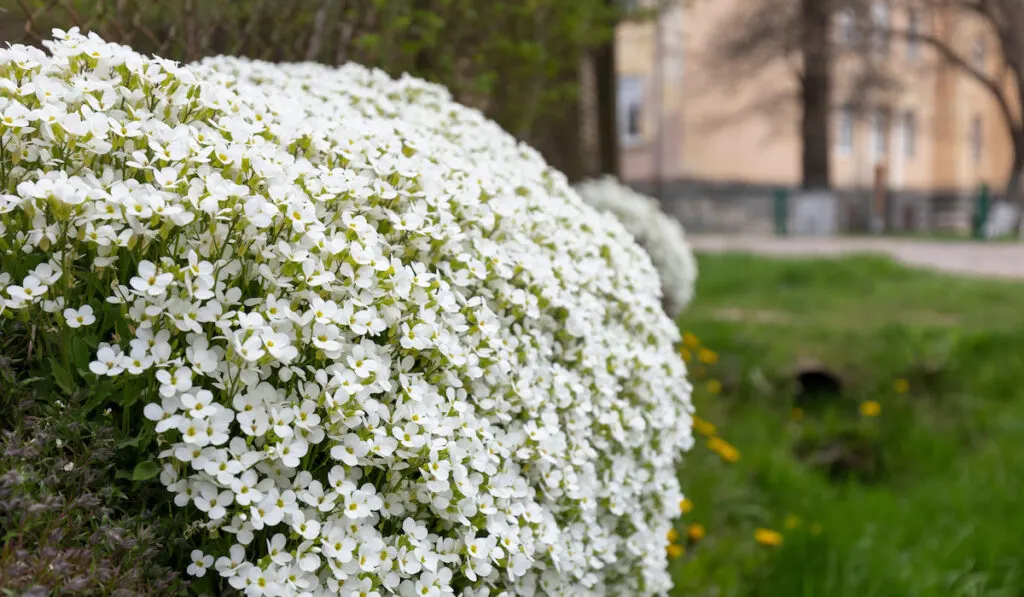
Aubrieta is a perennial cover plant, and its flowering carpets can reach a height of 4 inches.
In early spring, Aubrieta ‘Regado White’ is one of the first plants in the garden to bloom with a brilliant display of white flowers. Repeat flowering in the fall is possible, but the results won’t be as abundant as in the spring.
The plant has numerous small, beautiful silver leaves when not in bloom.
Aubrieta is beautiful in rockeries and flower gardens. With its overhanging blossoms, it is perfect for slopes and walls. And it will also strengthen the soil and keep it stable.
Aubrieta thrives in sunny conditions and can withstand drought.
The fact that Aubrieta draws pollinators like bees, butterflies, and hummingbirds is a gorgeous addition to any garden.
Key information:
- Hardiness zones: 5-7
- Heat zones: 5-7
- Mature size: 4-9” height; 1-2’ wide
- Prefers full-sun locations
- Heavy blooming
- Flowers come in many colors
- Grows quickly
- Soil tolerant
- Drought and heat tolerant
- Low cultivation requirements
- Attractive to bees, butterflies, and hummingbirds
7. White Stonecrop
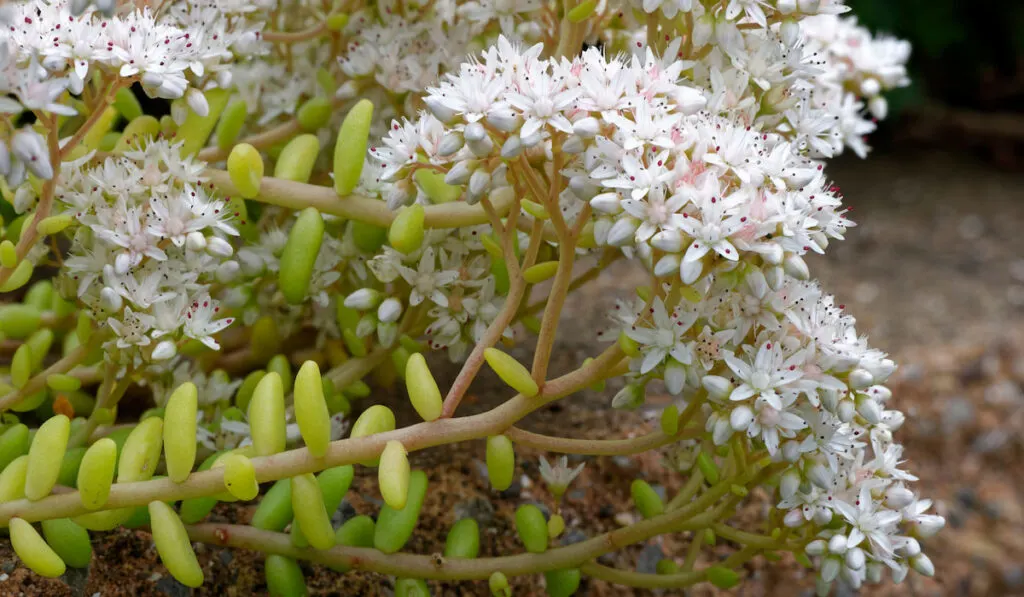
White stonecrop, or Sedum album, is an exceptionally hardy evergreen succulent. The low, dense ground cover that white stonecrop creates is attractive all year long.
White stonecrop’s small, attractive leaves begin bright green and turn crimson red in the fall. The small blooms appear in abundance in June are white and star-shaped and remain on the plant until August.
This plant does best in full sun to partial shade and in light, well-drained, dry soil. Avoid planting in heavy, clay soil.
While this plant can survive freezing temperatures and a snowy winter, it can also withstand dry conditions.
White stonecrop is versatile in many settings, including rock gardens, flower walls, flower beds, and as a border or groundcover plant. Also, it thrives when cultivated in a pot.
Key information:
- Hardiness zones: 3-8
- Mature size: 3-6” height; 1-2’ wide
- Prefers full-sun locations
- Soil tolerant
- Drought and heat tolerant
- Low cultivation requirements
- Turns an attractive crimson red in the fall
8. Japanese pachysandra ‘Green Carpet’

Pachysandra is a low, slow-growing plant with glossy, evergreen, deep green leaves that look appealing throughout the year.
‘Green Carpet’ grows about 8 inches tall, and as the name suggests, it makes a dense, deep green carpet. It’s an excellent groundcover that fills empty spaces nicely.
In May, this plant is topped with small, white, or slightly pink, spike-like flowers with a delicate, sweet fragrance.
The plant is simple to cultivate and requires little maintenance. It makes a dense, emerald carpet that doesn’t need to be watered or weeded and looks nice all year long.
‘Green Carpet’ grows best in a spot with shade, although it will also cope in places with more sunlight. It grows healthy and strong in average garden soil.
It is entirely frost-resistant, but damage to the leaves may occur in freezing, snowless winters. If so, new growths in the spring will quickly replace them.
‘Green Carpet’ is ideal for planting beneath the shade of broad trees. It can also replace a lawn in shaded areas.
It’s a great groundcover that looks nice and fills empty spaces. It keeps weeds from growing and adds greenery to dark places in the shade.
Key information:
- Hardiness zones: 4-8
- Heat zones: 1-8
- Mature size: 6” – 8” height; 1’ – 2’ wide
- Prefers full sun and partial shade
- Grows quickly
- Helps to prevent erosion
- Soil tolerant
- Tolerant to urban pollution
- Drought and heat tolerant
- Low cultivation requirements
- Recipient of the Award of Garden Merit (AGM)
9. Sagina subulata Irish Moss
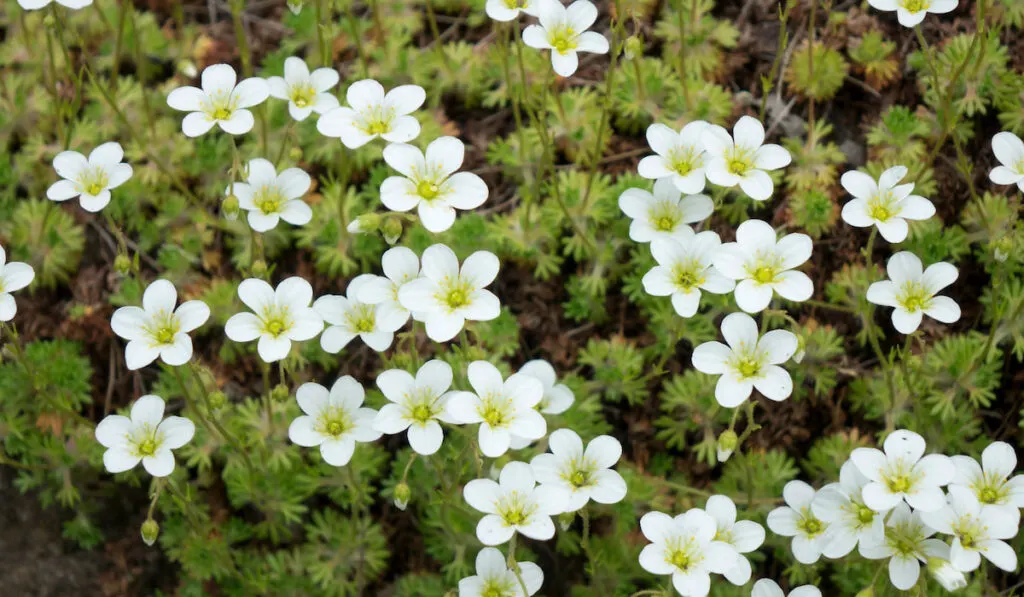
Sagina subulata, commonly known as Irish Moss, is a low-carpet plant with small, very compact, juicy green leaves. This groundcover plant has the appearance of moss and produces delicious, tiny white blooms in the summer.
It only grows a few inches tall and spreads widely. It is an excellent plant for filling empty spaces and preventing the growth of weeds. Green sheets of Irish Moss cover cracks, gaps, and empty places between other plants of all sizes.
Sagina subulata improves the appeal of every landscape by helping foreground the colors of other plants.
It has low requirements and grows well in bright spots in most garden soils. Soil should be kept moist, and you should avoid lengthy periods of drought. It is a completely frost-resistant species.
The resemblance of Irish Moss to actual moss makes it an ideal plant for rustic and natural garden settings.
Key information:
- Hardiness zones: 4-8
- Mature size: 1-2” height
- Spreads widely
- Prefers full sun and partial shade
- Prefers well-drained, moist soil
10. Cornus canadensis Bunchberry
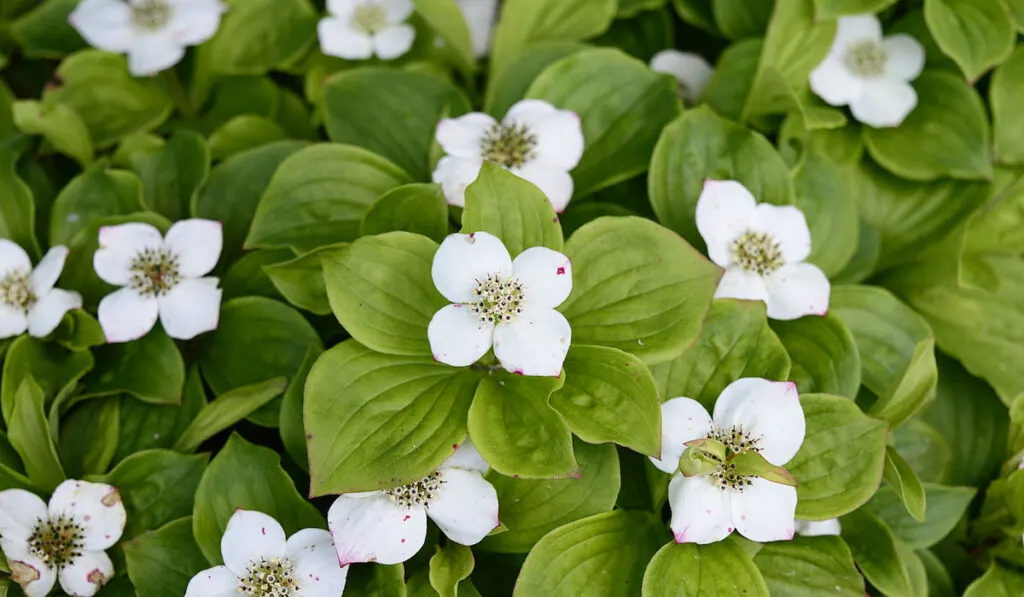
Cornus canadensis, also known as Bunchberry, is a low plant that looks good all year.
It can grow to a height of 9 inches, making it ideal for filling empty spaces in the garden. Bunchberry’s straight, green shoots grow leaves with unique, ribbed veins.
This plant blooms in the latter half of May and the first few days of June. Its light green leaves and white blossoms create a lovely contrast.
In the summer, you’ll notice red, round fruits gathered in clusters among the leaves. The fruits will remain on the plant throughout the winter and into the spring. The red fruits contrast beautifully with the green leaves, making the plant attractive all year.
Bunchberry leaves turn brilliant reds and yellows in the fall.
A cold, moist, and shady location is ideal for growing Cornus canadensis. Its cultivation requires acidic, well-drained soil, and it is a frost, pest, and disease-resistant plant.
Shaded areas look especially nice when accented with Cornus canadensis. It covers empty spots in flower beds and around tree bases nicely. Cultivating it in containers on a balcony or terrace is also possible.
Key information:
- Hardiness zones: 2-7
- Heat zones: 1-7
- Mature size: 4-9” height; 6”-1’ wide
- Prefers full sun, partial shade, and shaded locations
- Prefers well-drained, moist soil
- The plant produces red, berry-like fruits
- Autumn leaves turn red and yellow
11. White Flowering Periwinkle

Periwinkle is probably the best groundcover plant you will ever come across in any garden across the United States.
Plant it in a partially shaded or shady part of your garden and watch it flourish. Any corner of the garden can be made more cheerful by the presence of its tiny, brilliant white flowers.
The earliest periwinkle blooms appear in March, while the last fade in May. Even though periwinkle flowers usually bloom in the spring, you might find some on your plant during the summer.
It grows best in a shaded or semi-shaded location, although it can also grow in a sunny location. It simply requires additional moisture. Water the plants until they are firmly rooted in the first several weeks after planting.
Periwinkle is ideal for covering empty areas beneath trees or bushes and can also replace lawns.
Plant it in perennial beds but remember that it grows quickly and can crowd out other plants. It’s also great for borders, rockeries, and planting on slopes.
Key information:
- Hardiness zones: 4-9
- Heat zones: 1-9
- Mature size: 4-6” height; 2-3’ wide
- Prefers partial shade and shade locations
- Prefers well-drained, moist soil
- Creates a dense blanket of evergreen leaves
- Low cultivation requirements
- Soil tolerant
- Drought and heat tolerant
Final Thoughts
Use groundcover plants with white flowers to give your garden a classic, elegant look. They come in various shapes and sizes and are available for all climates. From areas with full sun to partial or full shade, there is a ground cover with white flowers for all garden types.
Resources
Both my wife and I are gardening enthusiasts and we have many species of plants and vegetables in our garden. Some of the information in this article is from my own experience.
- https://www.gardenia.net/plant/iberis-sempervirens-evergreen-candytuft
- https://www.rhs.org.uk/plants/trials-awards/award-of-garden-merit
- https://www.gardeningexpress.co.uk/ground-cover-fairy-rose-white
- https://www.gardenia.net/plant/cerastium-tomentosum-snow-in-summer
- https://www.gardenia.net/plant/phlox-subulata-white-delight-creeping-phlox
- https://www.wilsonbrosgardens.com/thymus-praecox-albiflorus-white-creeping-thyme-5in.html
- https://www.rhs.org.uk/plants/375942/aubrieta-regado-white/details
- https://www.gardenia.net/plant/sedum-album
- https://www.gardenia.net/plant/pachysandra-terminalis-green-carpet-japanese-spurge
- https://www.gardenia.net/plant/sagina-subulata
- https://www.gardenia.net/plant/cornus-canadensis
- https://www.gardenia.net/plant/vinca-minor-alba
